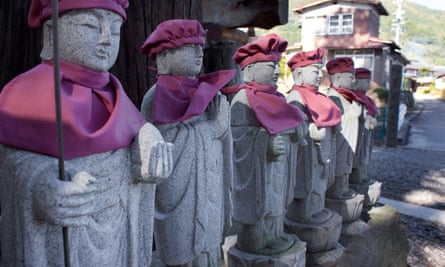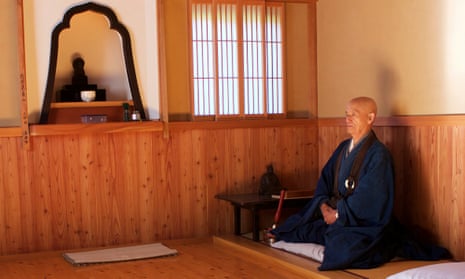Perched on a hilltop and surrounded by mountain forests ablaze in autumn reds and yellows, Kaigenji is a picture postcard image of old Japan. The stone steps leading to the entrance of the 300-year-old Zen Buddhist temple take visitors past a lovingly tended landscape of rocks, trees and pale gravel raked into swirls to symbolise water.
Inside, the head priest, Bunkei Shibata, is in a contemplative mood. But it is not the path to enlightenment that occupies his thoughts. Instead, he is pondering the future of his, and tens of thousands of other Buddhist temples across Japan.
Over the next 25 years, 27,000 of the country’s 77,000 temples are expected to close, in one of the biggest existential crises facing Japanese Buddhism since it was introduced from Korea in the sixth century.
Its decline mirrors that of hundreds of small communities that have traditionally helped finance their local temple. In a report released last year, the Japan Policy Council warned that if the exodus, particularly among young women, from rural areas continues at the current rate, almost half of Japan’s municipalities will disappear by 2040, along with their places of religious worship.
With no parishioners left to pay for their upkeep, temples will have no choice but to close their doors for good, according to Hidenori Ukai, a journalist and depute head priest of Shogakuji temple in Kyoto.
“The popular image of Buddhist priests as wealthy might still be true in big cities like Tokyo and Osaka, but it’s not the case elsewhere,” said Ukai, author of Vanishing Temples: the Loss of Rural Areas and Religion.
“At my temple, we have about 120 local patrons, but you need at least 200 to make a living,” added Ukai, who, like many priests, decided to pursue a second career.

Not even Japan’s busy funeral industry appears able to come to Buddhism’s rescue. While almost 1.3 million Japanese died last year, few relatives can afford the millions of yen it costs to hold a traditional Buddhist funeral. More are opting for cheaper, secular ceremonies, while priests say they feel duty-bound to drastically lower costs to give deceased parishioners a fitting sendoff.
“Japanese Buddhism has gone on a strange direction,” said Shibata, a retired businessman who traces his interest in Zen Buddhism to early-morning meditation sessions as a child. “These days most people associate it with funerals, but there is much more to it than that.”
Some priests are attempting to reverse the decline and challenge the “funeral Buddhism” image by opening temple cafes, supporting volunteer activities and hosting music and theatre productions. In Tokyo, priests at Vowz Bar dispense spiritual guidance along with alcohol, to their young clientele.
The crisis facing Japanese Buddhism isn’t a simple matter of demographics. In the early 1700s, Japan’s population stood at around 30 million – almost 100 million fewer than today – yet there were 46,000 temples. Surveys show that an increasing number of Japanese regard organised religion as inaccessible, cheerless and – since the 1995 sarin gas attack on the Tokyo subway by the Aum Supreme Truth doomsday cult – even dangerous.
“In this kind of environment, new membership recruitment will remain difficult,” said Mark Mullins, a professor of Japanese studies at the University of Auckland. “There may be some winners in the shrinking religious market, but it seems likely that most religious organisations will be struggling to maintain their institutions and activities as the number of active clergy and members continues to decline.”
That goes as much for priests as for followers. More than 12,000 Japanese temples have no resident priest, according to a recent survey by the Asahi Shimbun, as the pool of young people interested in the priesthood continues to dwindle.
Shibata, who trained with the Rinzai-Myoshinji sect before being sent to Nagano prefecture, says Buddhism must start dismantling the wall it has built around itself, before it is too late.
For Japanese Buddhism to survive another 1,500 years, he believes 50 percent of priests should be appointed from outside the traditional family succession route, although he concedes that “there is resistance” to the idea among traditionalists.
Undaunted, Shibata is trying to turn Japan’s skewed demographics to the religion’s advantage by reaching out to retirees who want to fill their twilight years with more than rounds of golf and trips to hot springs.
“Years ago people reckoned they had about 10 years left after retirement, so they would just try to enjoy themselves,” said the 80-year-old, who trained as a priest after his retirement in 2006. “But people are living much longer now, and they want to do something more meaningful with their time after they retire.
“Older people have a wealth of life experiences and that makes them ideal material for the priesthood. And, let’s be honest, the older you get, the more you think about your own mortality, and the more open you are to religious ideas.”
Of the 47 people, including a small number of women, who have completed his course for retirees, 23 have gone on to train as priests, and seven are now running their own temples.
“Society is changing at a rapid rate, but the Buddhist world has missed out on that because its connection with ordinary people is focused on funerals and memorials for the dead,” Shibata said.
Funerals aside, the modern priest, he insists, must act as a mentor and counselor and, crucially, to spread Buddhist teachings to a skeptical public.
He points to the community role Buddhism played in the aftermath of the March 2011 earthquake, when temples opened their doors to survivors, and priest and monks walked the length of the disaster zone offering spiritual advice and comfort.
“That’s exactly what they should be doing. When people are going through difficult times in their lives, it is our responsibility to help them.”

Comments (…)
Sign in or create your Guardian account to join the discussion